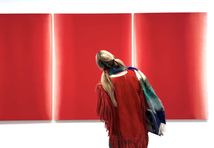“It’s a bit Chinatowny”
- The Courtauldian
- Oct 27, 2020
- 4 min read
A Fresh Look at Englishness in Liu Xiaodong’s New England (新英格兰), 2019
by Ashleigh Chow | 27 October 2020
Nestled in the heart of London’s Mayfair at Massimo de Carlo, Liu Xiaodong’s latest exhibition New England (6 Oct - 21 Nov 2020) presents a series of intimate portraits, aimed at suggesting a new history of an emerging Chinese diaspora. Painted during a visit to London in June 2019, Liu produces a fresh and brilliant new perspective on Englishness.
The aptly titled New England depicts the wave of young Chinese professionals choosing to leave the Middle Kingdom and settle in the Queen’s isle. Their professional expertise are visible in the portraits, as are their stories, personal histories and unique perspectives on their new home. Accompanying the portraits is a 30-minute documentary film directed by Yang Bo and sound engineered by Shi Qian which reveal the relationships behind the warmhearted paintings.
“Your hat is very cool… 很喜欢 [I really like it].” One of the sitters, Ed Tang comments to Liu Xiaodong in a mixture of Mandarin and English. He’s referring to the painter’s fedora, which Liu explains was bought following an episode of unpredictable English weather at a polo match.
“It’s a bit Chinatowny,” the painter replies as the sitters, both siblings, nod shyly in agreement. Working amidst the bustle of the Tang’s family-restaurant at the Dorchester, China Tang, the fedora-capped Liu picks up his brush, and continues adding his painterly brushstrokes.

Screenshot from the accompanying documentary, dir. by Yang Bo, 2019

Vic&Ed, Brother and Sister, oil on canvas, 2019 (photo: the gallery)
Like the other sitters featured in the series, one senses a collective dissonance in the tone. With the fedora functioning as a metaphor, “chinatowny” is used neither as a compliment nor an insult, but instead works as a marker of one’s acceptance in their communities. While Chinatown once suggested a refuge for immigrants in a foreign space, these working professionals now flaunt their seamless assimilation into their adopted communities - perhaps signalling their outgrowing of the need for a sanctuary in Chinatown.
In the segment detailing the family portrait of the banker Geoffrey Yu, Mrs. Yu earnestly requests, “Please don’t have me painted as a Dongbei girl,” referring to the region of China she is originally from. “I am from Dongbei myself… I make everyone look as if they were from Dongbei,” Liu giggles in reply. The result is an almost life-size painting, framed by the wooden fences of their garden (presumably somewhere in the affluent Home Counties). The Yu family are stood proudly in their backyard, with the characteristic overcast English sky looming in the background.

Geoffrey Yu and his family, oil on canvas, 2019 (photo: the gallery)
The exhibition is riddled with these humorous contradictions, as notions of ‘Chineseness’ are traded for Englishness, as defined by the sitters and artist themselves. Chinese subjects are pictured in their very English surroundings, and while ironic at times, they demand the viewer to reconsider their own ‘English’ realities. In the accompanying documentary, Mr. Yu is shown marking his daughter’s Kumon worksheets, scribbling “100%, very good effort”.[1] On another note, this also proves a personal suspicion of mine: you can take parents out of China, but you cannot take the Tiger out of them.
The 18th C Jamaican-born Baron Thomas Beckford springs to mind. Scholars such as Simon Gikandi have argued that for Beckford, as a colonial baron and member of the middle-class without an aristocratic genealogy, the search for an ‘English’ identity resulted in an outward self-fashioning of politeness: through a repression and disavowal of the true self in exchanged for gentility. For Liu’s ‘New Englishmen’, also lacking an English genealogy, the paintings echo a new variation of this self-fashioning.

Johann Zoffany, The Dutton Family, 1771–72

Lucien Freud, Painter Working, Reflection, 1993

Stanleybaby, oil on canvas, 2019 (Photo: the author)
In his apartment in Mayfair, Stanleybaby lounges nude in front of his fireplace. The image marries the visual vocabulary of an eighteenth-century English conversation piece – books, a chimneypiece and tasteful décor – with the homoerotic nudity of Lucien Freud’s portraits, purposefully establishing itself within the long tradition of English portrait painting.
“I’m so happy to become one of them [nude subjects]… imagine!” Stanleybaby, an investor and entrepreneur in the luxury sector remarks of his antecedents in European painting tradition.
As viewers may note, there is something intensely liberating about the suggestive nature of this image. For many this will probably be their first time seeing an Asian male nude painted so vividly within a gallery space. Secondly, that presented with such confidence Stanleybaby extends beyond the ascribed ‘English’ performative politeness, instead inviting an informal personal encounter between the viewer and the sitter. Drawing upon histories of painting styles and nude subjects, Liu inserts himself (and Stanleybaby) boldly into the traditions of English portraiture. But instead of mere conformity, he also imbues it the painting with an aura of unrestraint liberation – hinting at certain expectations, and yet simultaneously transcending them.
While throughout the documentary the “chinatowny” fedora marks Liu as unmistakably Chinese, his sitters appear in different configurations of their selfhood. While Thomas Beckford saw his Jamaican heritage and homosexuality as a barrier to embodying conventional 18th century English politeness, in a similar register Liu quietly manoeuvres through a series of social anxieties and expectations. But his paintings offer a more optimistic ‘Englishness’, one that is omnipresent in the experiences of these simultaneously Chinese and New English individuals. Bearing their own characteristics, each sitter exudes their own incomparable charm. While they may be intentionally repressing a facet of the self, they are also exploring it, in turn producing a delicate balancing act that can ultimately only be understood in terms of their personal histories of cultural exchange.












Comments